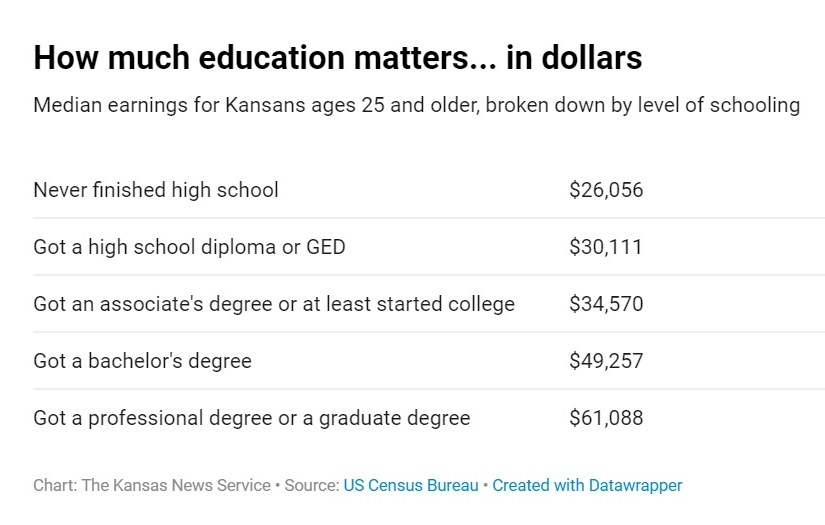by Celia Llopis-Jepsen, Kansas News Service
Life is expensive. Rent, health care, raising a family, saving for retirement — it adds up. But so does college debt. In fact, the cost of college shot up many times faster than typical U.S. earnings in recent decades.
So, what to do after high school? Here’s what you need to know.
College is your best bet for higher earnings long-term.
Only three in 10 people who stop at a high school diploma will manage to land what Georgetown University researchers term “good jobs” — jobs that will earn you at least $35,000 in your mid-20s through early 40s, and at least $45,000 after middle age.
And the bulk of those “good jobs” for people with a high school diploma alone go to men.
“If you’re a young woman,” says Georgetown economist Nicole Smith, “there are very, very few opportunities for you.”
On the whole, bachelor’s degrees bring home bigger paychecks than two-year programs. Take a peek:

Not all four-year degrees offer clear-cut paths to great paychecks.
In today’s era of college debt, it’s worth knowing not just what you’ll pay for college, but what you’ll earn. Nearly a third of U.S. adults have bachelor’s degrees nowadays. That means the letters “B.A.” or “B.S.” on your resume don’t carry the same weight they did back when those distinctions were rare.
Georgetown’s interactive college majors tool shows you incomes nationally or by state. The average arts major in Kansas earns $42,000. A bachelor’s in psychology, social work or education will earn you about the same. Majors like health, communications and biology land in the $50,000 range. Math, computers, architecture and engineering reach the $80,000 range.
The cost of your degree can vary a lot — even at public, in-state universities.
Use Kansas DegreeStats to compare costs and outcomes of specific degrees at in-state public two and four-year colleges. A quick search for aerospace engineering, for example, indicates that degree costs $20,000 more at the University of Kansas than Wichita State. Yet a degree from either school will set you up for the same sort of pay five years after graduation. It also reveals how much students tend to receive in scholarships and other helpful information.
To save on a four-year degree, you could start at a community college then transfer. But be sure to check which credits will transfer, so you don’t end up losing time and money.
Consider community and technical colleges for a faster, cheaper path that sometimes comes with a bigger payoff than four-year education.
Among the hundreds of degrees available at public two and four-year colleges in Kansas, the one that pays the best five years after graduation is an associate’s degree, not a bachelor’s: an electrical lineman program.
Nationally, Georgetown says two-year grads with science, technology, engineering — or STEM — degrees earn an average of $60,000 and those with two-year health degrees earn $52,000. Even some shorter credentials in STEM, for example, can pay better than many bachelor’s degrees.
Celia Llopis-Jepsen is a reporter for the Kansas News Service, a collaboration of KCUR, Kansas Public Radio, KMUW and High Plains Public Radio covering health, education and politics. You can reach her on Twitter @Celia_LJ.
Kansas News Service stories and photos may be republished at no cost with proper attribution and a link to ksnewsservice.org.
See more at https://www.kcur.org/post/college-costs-more-ever-can-you-afford-skip-it-consider-these-5-things
